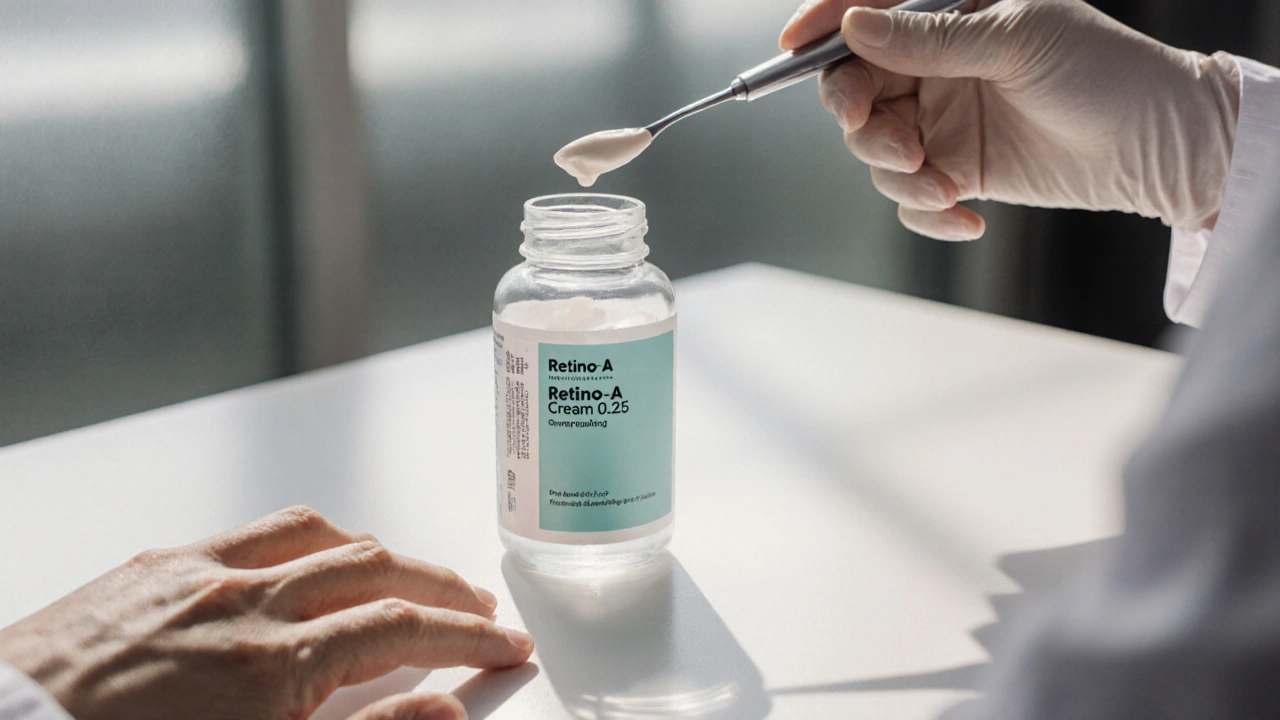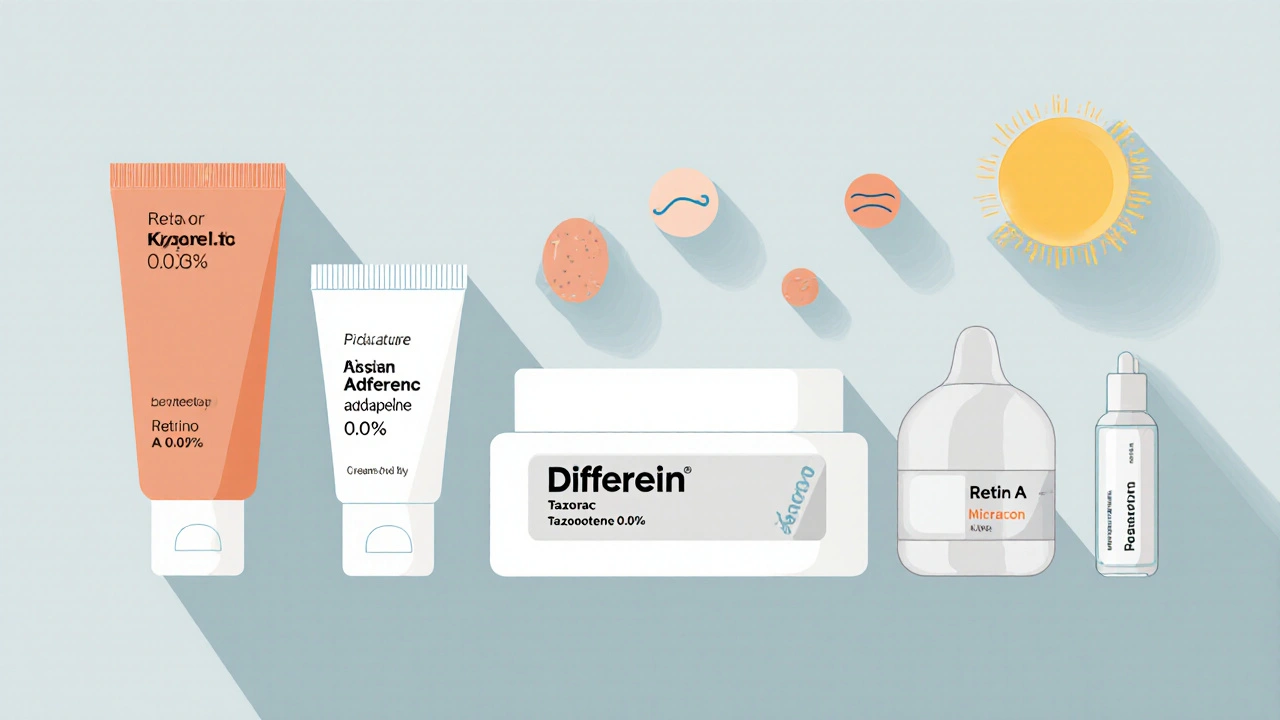Retino A Cream 0.025 (Tretinoin) vs Other Retinoids: A Practical Comparison

Retinoid Recommendation Tool
Find Your Perfect Retinoid Match
Answer these simple questions to determine which retinoid product is right for your skin concerns, tolerance, and budget.
Quick Takeaways
- Retino A Cream 0.025 is a prescription‑strength tretinoin gel prized for both acne and anti‑aging.
- Alternatives fall into three groups: prescription retinoids (e.g., Tazorac), over‑the‑counter retinoids (e.g., Differin), and pure retinol products.
- Key decision factors are concentration, irritation potential, cost, and whether you need a prescription.
- For severe acne, stronger tretinoin or tazarotene usually wins; for mild breakouts or first‑time users, adapalene or retinol may be gentler.
- Always test on a small skin area first and use sunscreen daily, regardless of the product you choose.
When you search for a solution to acne or fine lines, Retino A Cream 0.025 is often the first name that pops up. It contains tretinoin, a synthetic vitaminA derivative that speeds up skin cell turnover and boosts collagen production. But tretinoin isn’t the only retinoid on the market. This guide breaks down how RetinoA stacks up against the most common alternatives, so you can pick the right one for your skin type, budget, and goals.
What Makes RetinoA Cream 0.025 Unique?
RetinoA belongs to the tretinoin family. At a 0.025% concentration, it’s considered a low‑dose prescription formula, which means a dermatologist usually writes the script. The low dose reduces irritation while still delivering the classic benefits:
- Acne control: unclogs pores, reduces comedones, and shrinks inflammatory lesions.
- Anti‑aging: stimulates new collagen, softens fine lines, and evens skin tone.
- Hyperpigmentation: fades post‑inflammatory marks faster than many OTC options.
Because tretinoin works at the cellular level, results often appear after 8-12weeks of consistent nightly use. The trade‑off is a higher chance of redness, peeling, and sun sensitivity, especially during the first month.
How RetinoA Works - The Science in Plain English
RetinoA binds to nuclear retinoic acid receptors (RARs) inside skin cells. This triggers a cascade that:
- Increases the turnover of keratinocytes, pushing old, clogged cells out of the pore.
- Boosts fibroblast activity, leading to more collagen and elastin.
- Reduces the activity of melanocytes, which helps fade dark spots.
The end result is smoother, clearer skin-but only if you keep the barrier protected with moisturizer and sunscreen.

Key Criteria for Choosing a Retinoid
When you line up alternatives, focus on these five factors. They’ll help you decide whether a product matches your skin’s tolerance, your budget, and your treatment goals.
- Active ingredient & concentration: Higher percentages mean faster results but also more irritation.
- Prescription requirement: Some retinoids need a doctor’s script; others are sold OTC.
- Primary indication: Acne, aging, or both?
- Cost per month: Prescription tretinoin can be pricey without insurance, while OTC retinoids are usually cheaper.
- Side‑effect profile: Dryness, redness, and photosensitivity vary across compounds.
Side‑by‑Side Comparison
| Product | Active Ingredient | Typical Strength | Prescription? | Primary Use | Common Side Effects |
|---|---|---|---|---|---|
| Retino A Cream | Tretinoin | 0.025% | Yes | Acne + Anti‑aging | Redness, peeling, sun sensitivity |
| Differin Gel | Adapalene | 0.1% | No | Mild‑moderate acne | Dryness, mild irritation |
| Tazorac Cream | Tazarotene | 0.05% | Yes | Acne + Psoriasis, stronger anti‑aging | More intense peeling, erythema |
| Retinol Serum | Retinol (natural) | 0.3-1% | No | Anti‑aging, mild acne | Gradual irritation, less potent |
| Retin‑A Micro | Tretinoin | 0.01% (micro‑dose) | Yes | Very sensitive or beginner skin | Minimal irritation, slower results |
Deep Dive Into the Alternatives
1. Differin (Adapalene 0.1%) - The OTC Favorite
Adapalene is a third‑generation retinoid designed to be less irritating. It’s sold over the counter in many countries, making it a go‑to for first‑time users. While it’s excellent for comedonal acne, its anti‑aging effects are milder compared to tretinoin.
2. Tazorac (Tazarotene 0.05%) - The Potent Prescription Option
Tazarotene is a newer‑generation retinoid that works faster than tretinoin but also brings more redness and flaking. Dermatologists prescribe it for stubborn acne, psoriasis, and advanced photo‑aging.
3. Retinol - The Cosmeceutical Classic
Retinol is the natural precursor to tretinoin. When applied, skin enzymes convert it step‑by‑step into the active acid. Because conversion is slow, retinol is gentler but requires higher concentrations (often 0.5%-1%) to achieve comparable results.
4. Retin‑A Micro - Ultra‑Low‑Dose Tretinoin
This prescription product ships in a micro‑dose formulation (0.01%). It targets people who have hit a “retinoid ceiling” - they can’t tolerate higher strengths without severe irritation. It’s a stepping stone toward full‑strength tretinoin.

Which One Is Right for You?
Below is a quick decision tree. Answer the questions, then scroll to the matching recommendation.
- Do you have a prescription from a dermatologist?
- Yes - consider RetinoA (0.025%) or Tazorac.
- No - look at Differin or a retinol serum.
- Is your primary concern acne, aging, or both?
- Acne only - Differin (mild‑moderate) or Tazorac (severe).
- Aging only - Retinol or low‑dose Retin‑A Micro.
- Both - RetinoA offers balanced results.
- How tolerant is your skin?
- Very sensitive - start with Retin‑A Micro or a low‑dose retinol.
- Average tolerance - RetinoA 0.025% or Differin.
- Robust, no‑issue skin - Tazarotene can be used safely.
- What’s your budget?
- Low - OTC retinol or Differin.
- Medium - RetinoA (often covered by insurance).
- High - Tazorac or custom compounding.
In practice, many dermatologists start patients on Differin or a low‑dose retinol, then switch to tretinoin once the skin builds tolerance. If you’re looking for the fastest anti‑aging payoff and you can handle a prescription, RetinoA 0.025% is a solid middle ground.
Practical Tips to Minimize Irritation
- Begin with two nights a week, gradually increasing to nightly use.
- Apply a pea‑sized amount to clean, dry skin; avoid the eye area.
- Follow up with a fragrance‑free moisturizer within 15minutes.
- Never skip sunscreen - SPF30+ broad‑spectrum is a must.
- If severe redness persists, pause for a few days, then resume at a lower frequency.
Frequently Asked Questions
Can I use RetinoA and Differin together?
No. Both are retinoids and will amplify irritation. Choose one product and stick with it, or alternate weeks if a dermatologist advises.
How long does it take to see results with RetinoA?
Most users notice smoother texture after 4‑6weeks, but significant acne clearance or wrinkle reduction often requires 8‑12weeks of consistent use.
Is RetinoA safe during pregnancy?
No. Tretinoin is classified as CategoryC - it may pose risks to the fetus. Pregnant or trying‑to‑conceive individuals should avoid all retinoids.
Can I use RetinoA on my body (e.g., back or chest) for acne?
Yes, but apply a thin layer and monitor for excess dryness. Some people prefer a lower‑strength formula like Retin‑A Micro for larger body areas.
Do I need a dermatologist to get RetinoA?
In most countries, tretinoin is prescription‑only, so a dermatologist or GP must write it. Some tele‑medicine services now provide online prescriptions after a brief consultation.
Bottom Line
RetinoA Cream 0.025% sits in the sweet spot between mild OTC retinoids and ultra‑potent prescription options. If you can handle a prescription and want a balanced acne‑plus‑anti‑aging result, it’s a strong contender. For those who can’t get a script, Differin offers a gentler entry point, while retinol remains a backup for pure anti‑aging without the acne punch. Always consider your skin’s tolerance, the specific issue you’re targeting, and your willingness to commit to a daily routine with sunscreen. With the right choice, you’ll see clearer, smoother skin without unnecessary side effects.

Thank you for the thorough comparison; it provides a clear framework for evaluating both prescription and over‑the‑counter options. The breakdown of active ingredients, concentrations, and side‑effect profiles is particularly useful for clinicians guiding patients through personalized treatment plans. Maintaining a consistent nighttime routine while emphasizing sunscreen use remains essential for minimizing irritation and maximizing results.
Yo, love the depth here! The way you split the retinoids by prescription status and skin tolerance is spot on. For anyone new to the game, start low‑dose-think micro‑dose tretinoin or adapalene-to build up that barrier before jumping to 0.025% Retino A. Also, remember the classic: buffer with a moisturizer 15 minutes after application to keep that peel in check.
This guide strikes a hopeful chord; it shows that with patience and the right product, smoother skin is achievable. 😊 The balanced view of efficacy versus irritation encourages readers to make informed choices without feeling overwhelmed.
While the data presented is commendable, one must recognize the nuanced superiority of a meticulously calibrated tretinoin regimen. The quintessential elegance of a low‑dose prescription formula lies not merely in its chemical potency but in its capacity to orchestrate dermal homeostasis with understated grace.
The analysis is both comprehensive and accessible. I appreciate the precise language used to delineate each product’s mechanism of action, which aids readers in matching their individual dermatologic concerns with the appropriate therapeutic agent.
All this talk about "prescriptions" and "clinical trials" is a distraction. The real truth is that the pharma giants are hiding cheaper, natural alternatives that work just as well. If you’re not buying the mainstream brands, you’re being fed a lie about what actually benefits your skin.
Great summary.
Understanding retinoids is like stepping into a vast library of skin science, where each shelf holds a different formulation waiting to be explored. First, recognize that tretinoin, the active form in Retino A, is a direct ligand for nuclear retinoic acid receptors, catalyzing cellular turnover at a rapid pace. This rapid turnover translates into clearer pores and smoother texture, but it also means the barrier can become temporarily compromised. Second, the concentration matters: 0.025% offers a gentler onset compared to higher strengths, reducing the likelihood of severe erythema. Third, the vehicle-cream versus gel-affects absorption; gels tend to dry faster and may be preferable for oily skin, while creams provide additional occlusion for dry types. Fourth, the regimen should be built gradually; starting with two or three applications per week allows the skin’s adaptive mechanisms to catch up. Fifth, moisturization is non‑negotiable-apply a barrier‑repair moisturizer within 15 minutes to lock in hydration and mitigate peeling. Sixth, sun protection cannot be overstated; a broad‑spectrum SPF 30+ is essential to prevent photo‑damage amplified by retinoid‑induced photosensitivity. Seventh, monitoring is key: if persistent redness or scaling occurs, pause treatment and reduce frequency before resuming. Eighth, over‑the‑counter alternatives like adapalene or retinol provide a stepping stone for beginners, allowing the skin to build tolerance before escalating to prescription‑strength tretinoin. Ninth, each individual’s skin type-whether sensitive, normal, or robust-should guide product selection; those with heightened sensitivity may prefer Retin‑A Micro’s micro‑dose. Tenth, budgeting plays a role; insurance often covers prescription retinoids, making them more affordable than many premium OTC serums. Eleventh, the long‑term benefits include increased collagen synthesis, reducing fine lines and improving elasticity. Twelfth, be aware of contraindications-pregnancy, active eczema, or severe rosacea may preclude retinoid use. Thirteenth, comprehensive skin care routines that incorporate antioxidants can synergize with retinoids for enhanced results. Fourteenth, patience is vital; visible improvement typically emerges after eight to twelve weeks of consistent use. Finally, the journey with retinoids is personal, and finding the right balance of potency, frequency, and supporting products will yield the healthiest, most radiant complexion.
Thank you for the extensive rundown. As a dermatologist, I often advise patients to start low and go slow, especially when dealing with tretinoin. The emphasis on moisturization and sunscreen aligns perfectly with best practice guidelines. I’d also add that a gentle, non‑fragranced cleanser can further reduce irritation during the acclimation phase. Lastly, it’s important to note that individual response varies, so regular follow‑ups help tailor the regimen to each patient’s unique needs.
Oh great, another “ultimate guide” that pretends to have all the answers while ignoring the fact that most people just want a product that won’t make their face look like a peeling orange. Sure, follow the steps, use sunscreen, and pray the chemicals don’t turn you into a lobster.
The so‑called “science” behind these retinoids is heavily obscured by a network of corporate interests. While the guide mentions side‑effects, it conveniently omits the long‑term risk of dermal dysregulation caused by chronic exposure to synthetic retinoic acid. Patients should demand transparency and consider alternative, plant‑based pathways that are systematically suppressed.
Overall, this article provides a solid foundation for anyone considering retinoid therapy. It balances the technical details with practical tips, making it accessible to both newcomers and seasoned users. By emphasizing gradual introduction, moisturizer use, and diligent sun protection, it equips readers to achieve optimal results while minimizing adverse effects.